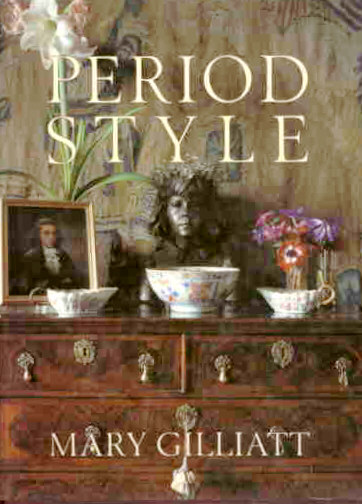
Another thing Betty and I both like is good, solid furniture. Well, actually, we can't afford much of it -- most of our furniture is remnant student-slum handmedowns. But once we finish getting $250,000 in medical school loans paid off, then we can get some more good furniture.
We decided to start furnishing our house in good style. But being a geeky outdoor sort of person, I didn't know squat about interior decorating. But also being a bookish sort, and knowing that library and bookstores exist, I figured that we could learn how to do it right with a little investigation. So we talked with one of Betty's friends from Texas who did interior design, and learned a bunch. One of the most important is that a room mostly has to make sense: most things in the room should blend in style. But it's OK to have one or two things that don't quite fit in, as long as they have personal relevance. A good rule to follow.
Then we got a book called Period Style; great book.

And, a book called The Elements of Style (not Strunk and White, but Architectural Style).

After some cogitation, we decided that we didn't want to slavishly try to recreate an exact period style, but maybe to mix a couple of compatible styles. So what we arrived at is a combination of the following.
Betty and I both took our degrees from (and met at) Jefferson's University: The University to alumni, the University of Virginia to all the rest of you barbarians. The grounds of the University ("campus" to the incognoscenti), designed by Jefferson himself, are one of the major architectural landmarks of the world. The UVA Web site has a guided tour of the architecture, not to be missed. So we loved Jefferson's Classical Revival style (a subset of the Federal style of the late 1700s and early 1800s). We don't have a hope of recreating anything monumental, and it would be out of place in our small house and middle-middle-class neighborhood in Pittsburgh. Nonetheless, Charlottesville is full of original small-scale (house-scale) examples of the Classical Revival style.
When we bought our present house, we decided to add a new dining room onto the back, replacing a dark screened-in porch. And of course, to do it up in a vernacular version of the Classical Revival style. It helped that we had a nice hand-me-down sideboard and drop-leaf table in a period style that fit right in with this. With the help of an architect and Ken Jackson, an excellent contractor who also attended The University (unfortunately he's moved to Colorado now), we designed the addition pretty much ourselves. I used Micrografx Designer, at that time the premier computer program for such arrchitectural drawings, and made up the design myself. Originally the architect had some psuedocolumns as part of the design, but we finally decided they were too much for such a modest addition. Here is one of the views from that long-agon computer diagram. Note the dentils at the top and the inset panels along the bottom; just very subtle Classical Revival details:

I've got some nice slides of the dining room and as soon as I can get them digitized I'll post them here.
There is also a place in Pittsburgh's SouthSide, Destiny Studios, that makes wonderful tiles in Celtic and related motif. Since part of the Arts and Crafts tradition is using a tile surround for the fireplace, we thought we'd eventually redo the fireplace, replacing the existing grey stone mantel with a warm, wooden one (hard to find big wooden beams now, though), and do a surround with Destiny's tiles. We still want to do this but it'll be a while until we can afford it. Here is my sketch:
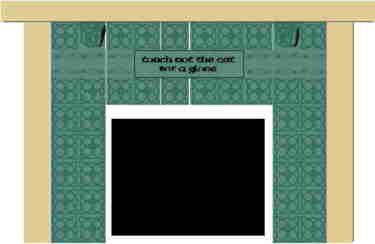
I'll be hanging my sgian dubh, dirk and claymore on the tiles, so it will be sort of a cross between Arts and Crafts style and Scottish Baronial. BTW for all you bloodysaxons who don't get Gaelic, that translates as "little black knife, big knife, and big sword." The sgian dubh, literally black knife, is what you see in a Scotsman's sock.
Many, many years ago in Scotland, it was considered impolite to bring weapons into a house, so you would leave them with your host at the door. (People who were impolite got hacked to death.) Over the centuries, manners generally improved, but Scotland was still a dangerous place. So the tradition developed to carry a hidden or "black" dagger in one's sleeve. And Scotland being Scotland, the English being the English (and the other Scots being Scots) it was probably a good idea to keep your sgian dubh with you even when visiting. In some cases you, while visiting your host, might be called on to defend the house against the English (or other Scots). And therefore the tradition grew that you pulled out your sgian dubh and stuck it in your sock, so it was "officially" hidden, so neither you nor your host would officially acknowledge its presence, but it was there in case you needed it.
And over the years, the Scots realized what a handy place one's sock was -- you could stick knifes, forks, spoons, a couple of oatcakes, a pen, a pencil, and a notebook in your sock and have them all handy.
Then Queen Elizabeth and Sir Walter Scott started a big PR campaign for Scotland, and it became "official" that one had to have a sgian dubh in one's sock -- going out without a sgian dubh was simply not done.
And about kilt tartan thing -- you know, wearing your clan tartan, and your mother's clan tartan as a tie and so forth -- it's all a concoction of the Madison Avenue firm of Windsor and Scott. It used to be that people wore tartans that they liked -- or more likely whatever was woven in your area and thus available. And because of this regional availability, certain tartans got associated with certain regional clans. "Hey, Robbie, that's a nice tartan you got there! I saw someone with that same tartan last month, from down south, I think." "Thanks, Duncan, I got it when I was on my way back from Loch Lomond; yes, all the folks around Balquhidder and Tyndrum are wearing this now. Attractive, don't you think?"
I have ancestors from different clans, even though mostly from Clan Mackintosh. And since several generations of my male ancestors served in the Highland Regiment, I chose the Dress Black Watch for my kilt. Mostly because I wear a kilt mostly on formal occasions, and Dress Black Watch looks good with black tie. And because I like it.
A colleage from the Cairngorm area of Scotland came up with an even better solution. Eric Pirie went to a kiltmaker and got a whole bag of scraps and made up his, I guess one would call it poly-chrome tartan kilt:
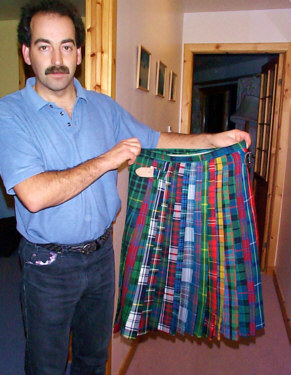
Here is Scottish Baronial, from Period Style:
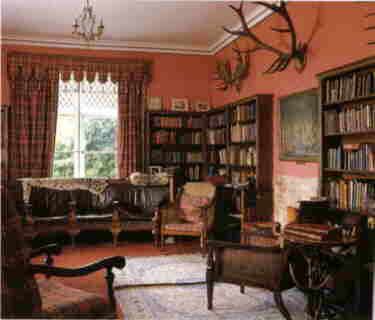
But the main style we fell in love with is the Arts and Crafts movement. It started in England as a reaction against the tawdry mass-produced industrial furniture and other implements of the Victorian era. In its original exposition, it empasized that items should be made in the medieval craft-guild style: a single Master-piece made by a master craftsman. Not everone bought fully into this medieval ideal, but the idea that things should be well-made and free of extraneous ornamentation is the core of the Arts and Crafts doctrine. We felt it appropriate, as in our general neighborhood there are many houses in the related Craftsman style (also closely related to Frank Lloyd Wright's Prarie Style of house-building); ours is a generally undistinguished two-story, but we do what we can with it. We learned more about house styles from this great book, sort of a nature-guide to houses:
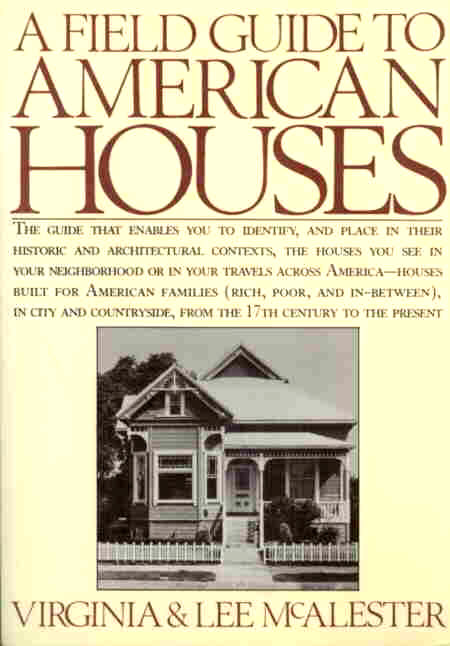
Here is a basic explanation of the Craftsman style, from this book:
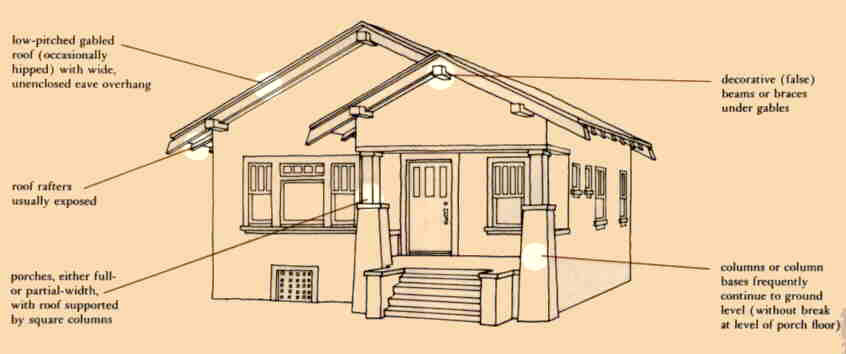
Here is an interior of Little Holland House in Surrey, England, a prized example of British Arts and Crafts,

Originally, I said that this was built in 1910 by its owner, Frank Dickinson. However, I was amazed -- and pleased -- to get this email in November of 2000:
"Dear Dr. Conover
I was amazed - and pleased - when searching the net to come across your
Style page, and a picture of the master bedroom of Little Holland House, which is one of the houses in my care.
One thing I would appreciate at some time if you would correct - Frank
Dickinson built the house between 1902 and 1904, moving in in March 1904 immediately following his marriage to Florence Marriott. They in fact
spent their wedding night and whole honeymoon in the house, working on it!
Although of course the frieze and wardrobe were not finished then, the two
panels on the dressing chest and the plaster frieze over the fireplace were wedding gifts from friends who worked with Frank at the Doulton
factory in Lambeth in London. However I think the date of 1910 is a little late for this room, which was considered important enough by Frank
to have it mostly finished when he moved in.
If you have any queries about the house or its history, don't hesitate to
contact me at valary.murphy@sutton.gov.uk
If you don't already know our website address, it is
www.sutton.gov.uk/lfl/heritage/lhh/index.htm
We are planning to put more images on there in the next few months.
In the U.S., this was known more-or-less as the Mission Style, best exemplified in architecture by the designs of Greene and Greene of Pasadena, California:

The prime proponents of the Mission Style in American furniture were the Stickley brothers. Original Stickley furniture has been prized in recent decades for its value -- Barbara Streisand payed umpty-ump thousand dollars for an original Stickley sideboard. But surprisingly, the L. and J.G. Stickley factory never (quite) closed since its inception; they've been making the same high-quality furniture since they opened. There were some hard times, but reportedly things are much better now.
Thus far, we've only got a Prairie Settle (in Stickley's paraphrase of Frank Lloyd Wright's Prairie Style that is so famous in the Chicago area), a Morris Chair and an ottoman. But, even though it costs two arms and a leg (anyone got a cheap source for Stickley furniture?), we definitely want more. This stuff is SOLID furniture that is comfortable and ages gracefully, and will last for centuries. Even though it doesn't look comfortable, it's without a doubt the most comfortable furniture we've ever sat in! Here are some of the subtle construction details from the current Stickley catalog:


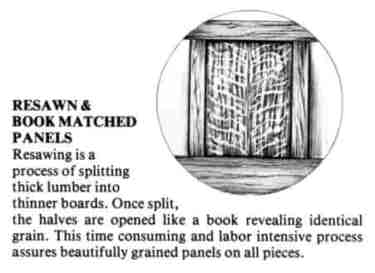
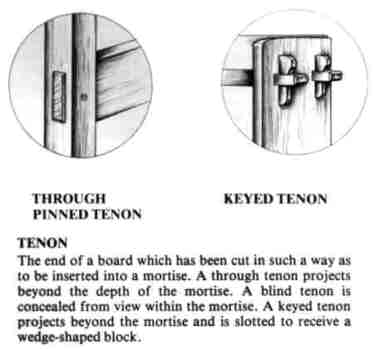
When looking for a more cost-effective alternative to actual Stickley furniture, other than non-Stickley Mission antiques, we found nothing but cheap (well, actually, moderately expensive) IMITATIONS. And by imitation, I mean furniture that looks like actual Arts and Crafts furniture, but instead of real through-pinned tenons, they just stick little pieces of wood on the post to make it look like a tenon! Yechh! The whole point of Arts and Crafts furniture is that the only ornamentation is that which comes from the integral construction methods. And this cheap imitation is exactly what the whole movement is against: tacked-on ornamentation! Stick up for philosophical purity, Craftsmanship, and the American Way; don't buy these cheap imitations!
 Go to Keith's Home Page
Go to Keith's Home Page Back to Keith's Personal Page
Back to Keith's Personal Page